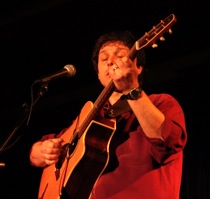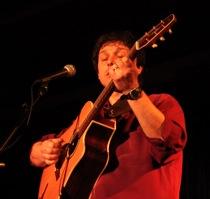
Photo by Mike Condie
I became a fan of Peppino D’Agostino, who will be performing July 11 at the Mendocino Music Festival, through the world of classical music. In 1998, D’Agostino met David Tanenbaum at the Schorndorf Gitarren festival in Germany and received such positive feedback from the encounter that they decided to work together. I was already a fan of Tanenbaum’s, but I'm always dubious of “crossover” music, since I frequently feel the combination of styles is forced and uninteresting. Classical guitarists sound stiff playing popular music, while the steel-string guitarists seem to lack respect for classical music.
Hearing D’Agostino and Tanenbaum proved me wrong. Tanenbaum was certainly loose enough to match his colleague’s more popular music, and D’Agostino certainly showed respect for the classical music. If you listen to the first track on their CD Classic/Steel (the Bach Sinfonia from Cantata No. 29, which some listeners will recognize as being quite similar to Bach’s Prelude to the E-major Violin Partita), the two guitars are integrated perfectly. D’Agostino finds ways of using the steel strings to increase the color palette. It never feels forced; instead, he uses his guitar to highlight certain types of lines, and to create a very modern orchestration of the material that is still true to the Bach.
Listen to the Music
But what really sold me on D’Agostino was Peter Maxwell Davies’ Farewell to Stromness. Here was a piece that truly did exist in that middle ground between classical and popular. Again, the colors that were present were exciting and innovative, and the two guitars never seemed to clash. Hearing the piece was a wonderful experience.
Thus was born a fan of Peppino D’Agostino. When I followed him onto his solo records, I found the exact same attention to detail, the same artistry of orchestration. He has a subtle touch both in the recording studio and on stage, and is able to bring out many more qualities and subtleties than I normally associate with steel-string guitar playing.
Almost anything could show up in his performance at Mendocino. His most recent CD, Made in Italy, is “A little portrait of Italy ... my thoughts and personal impressions of my native country.” The music comes from all over: the classics, film music, even some Rossini. “There’s a nostalgic element” to it, he says. “Some of those songs, I grew up with. I listened to those songs when I was a little kid. I decided to create my own arrangements.” The CD also includes a lot of his own singing, something that he has done only sporadically elsewhere.
These arrangements are truly moving. He finds a way of embracing his heritage, but also incorporating everything he has learned from his experiences of playing with various musicians, and learning from the many styles he has played in his career. He incorporates himself — as a multicultural, multistylistic being — back into the original music of his heritage.
“Italian music is not just about pizza, amore, and pasta,” he remarks. “It goes far beyond. Italian culture is misinterpreted by the media and by tourists. There’s a bunch of stereotypes. I get tired of that. Italy is like any other country. If you say America is New York or Los Angeles, that’s untrue. There’s so many nuances. There’s Milwaukee, New Orleans, Boston, Kansas City, and Nashville.” Just as there are many moods in the guitar work of Peppino D’Agostino.

